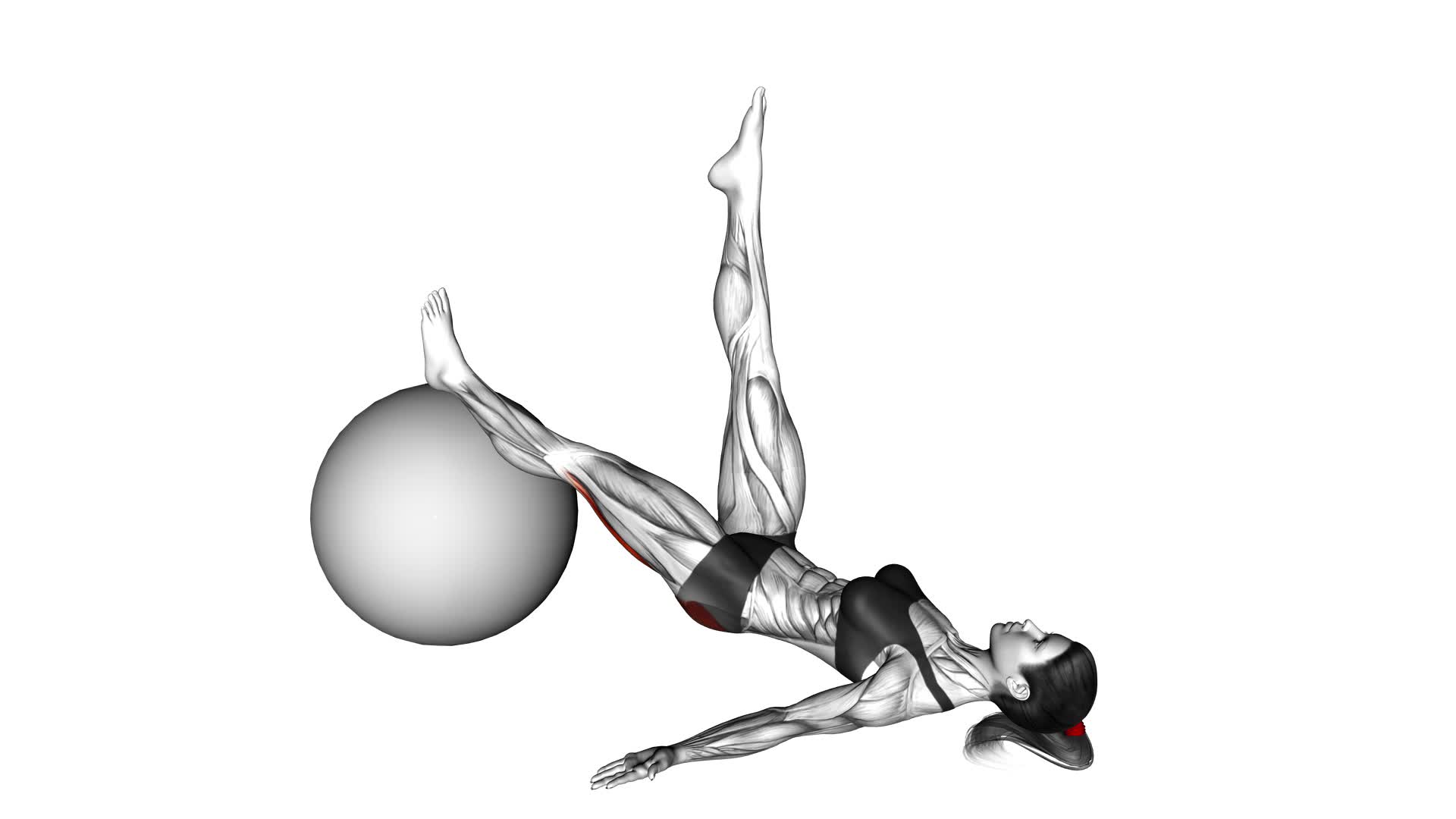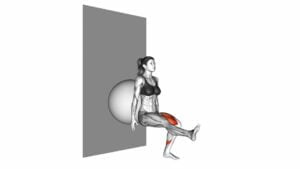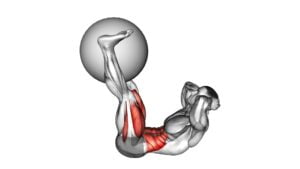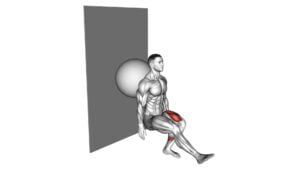Single Leg Extension (On Stability Ball) (Female) – Video Exercise Guide & Tips

Get ready to strengthen your legs and core with the single leg extension exercise on a stability ball.
Watch This Exercise Video
In this video exercise guide, we'll show you the proper form and technique, as well as modifications for beginners and advanced variations for those looking for a challenge.
With our helpful tips, you'll be able to maximize your workout and achieve your fitness goals.
So grab your stability ball and get ready to feel the burn!
Key Takeaways
- Single leg extension exercise strengthens the lower body and improves balance.
- It targets the quadriceps, hamstrings, and glutes while engaging the core muscles.
- Alternatives to the stability ball include using a bench, step, or chair, but it is important to maintain proper form and engage the core muscles.
- Beginners can modify the exercise by starting with both feet on the ball and gradually increasing the range of motion, while advanced variations can incorporate resistance bands and target additional muscle groups.
Benefits of Single Leg Extension
To maximize your workout, the benefits of the single leg extension exercise on a stability ball include strengthening your lower body and improving balance. This exercise targets your quadriceps, hamstrings, and glutes, helping to develop strong and toned legs. By performing the single leg extension on a stability ball, you engage your core muscles to maintain balance and stability, further enhancing your overall strength and coordination.
One of the main benefits of this exercise is its ability to strengthen your lower body. By isolating one leg at a time, you can focus on building strength in your quadriceps, hamstrings, and glutes. This can be especially beneficial for individuals who want to improve their athletic performance or increase their overall leg strength.
Additionally, the single leg extension on a stability ball helps to improve balance. When performing this exercise, your core muscles are engaged to maintain stability on the unstable surface of the ball. This not only challenges your balance but also improves your overall coordination and stability.
For beginners, modifications can be made to make this exercise more accessible. You can start by performing the single leg extension without a stability ball, keeping both feet on the ground for added support. As you build strength and confidence, you can progress to performing the exercise on a stability ball.
Equipment Needed for the Exercise
Before you begin the Single Leg Extension exercise, it's important to have the essential equipment on hand.
The main equipment needed for this exercise is a stability ball, which helps to engage your core and improve balance.
If you don't have a stability ball, you can use alternatives such as a bench or a chair.
Remember to always prioritize safety when using any equipment, ensuring it's stable and secure before starting the exercise.
Essential Equipment for Exercise
You will need a stability ball for the single leg extension exercise.
In addition to the stability ball, there are a few other essential pieces of equipment that you should consider for your exercise routine.
First, let's talk about exercise mats. There are different types of exercise mats available, such as yoga mats, pilates mats, and general fitness mats. Choose the one that suits your needs and provides adequate support and cushioning for your exercises.
Another important aspect is proper footwear. Wearing the right shoes is crucial to prevent injuries and ensure stability during your workouts. Make sure to wear shoes that are designed for the specific type of exercise you're doing, whether it's running, weightlifting, or any other activity.
Alternatives to Stability Ball
If you don't have access to a stability ball, there are alternative pieces of equipment that can be used for the single leg extension exercise. Some stability ball alternatives include using a bench, a step, or even a chair. These items can provide a stable surface for you to perform the exercise.
When using a bench, make sure it's sturdy and at a height that allows your leg to fully extend. A step can also work well, but be cautious of its height and stability. If using a chair, ensure that it's strong and secure.
Remember to maintain proper form and engage your core muscles throughout the exercise, regardless of the equipment you choose.
Safety Precautions When Using Equipment
When using alternative equipment such as a bench, step, or chair for the single leg extension exercise, ensure that the equipment is stable and at the appropriate height to fully extend your leg. Safety measures should always be a priority to prevent common injuries. Before starting the exercise, check that the equipment is in good condition, with no loose parts or wobbling.
Make sure the surface is non-slip and provides a secure grip for your feet. Take the time to adjust the height of the equipment to a level that allows for a full range of motion without straining your leg or compromising your balance. By following these safety precautions, you can reduce the risk of accidents or injuries during the exercise.
Now, let's move on to discussing the proper form and technique for the single leg extension.
Proper Form and Technique
To perform the single leg extension exercise on a stability ball with proper form and technique, follow these steps:
- Start by lying on your back on a mat or the floor with your arms by your sides and your feet resting on top of the stability ball.
- Engage your core muscles by drawing your belly button in towards your spine.
- Lift one leg off the stability ball, keeping it straight and parallel to the floor. This is your starting position.
- Slowly extend your leg straight out in front of you, while keeping your core engaged and your hips stable. Avoid any swinging or jerking motions.
- Pause for a moment at the end of the movement, then slowly return your leg back to the starting position.
- Repeat the exercise for the desired number of repetitions, then switch to the other leg.
Modifications for Beginners
For beginners, a helpful modification to the single leg extension exercise on a stability ball is to start with both feet resting on the ball instead of lifting one leg off. This modification allows beginners to develop balance and stability before progressing to the more challenging single leg variation.
When starting with both feet on the ball, make sure to keep your core engaged and your back flat against the ground. This will help maintain stability throughout the exercise. As you become more comfortable, you can gradually lift one leg off the ball and extend it straight, while keeping the other foot planted firmly on the ball.
Beginners often make the mistake of trying to lift their leg too high or losing control of the stability ball. It's important to focus on controlled movements and proper form to prevent injury. Start with small leg lifts and gradually increase the range of motion as you gain strength and stability.
Remember to breathe throughout the exercise and listen to your body. If you feel any pain or discomfort, stop immediately and consult a fitness professional. With consistent practice and proper form, you'll gradually build strength and stability in your core and legs.
Advanced Variations and Challenges
To challenge yourself further, try incorporating resistance bands into your single leg extension exercise on the stability ball. This advanced modification won't only engage your leg muscles but also add an element of resistance, making the exercise more challenging and effective.
Here are four advanced progressions you can try:
- Resistance band around ankles: Place a resistance band around your ankles and perform the single leg extension exercise. The resistance from the band will target your glutes, hamstrings, and hip muscles, intensifying the workout.
- Resistance band around thighs: Position the resistance band around your thighs and perform the single leg extension exercise. This will engage your inner and outer thigh muscles, providing a greater challenge for your legs.
- Resistance band with lateral movements: Attach the resistance band to a stationary object and perform lateral leg movements while doing the single leg extension exercise. This will work your hip abductors and adductors, improving your hip stability and strength.
- Resistance band with knee raises: Attach the resistance band to a stationary object and perform knee raises while doing the single leg extension exercise. This will target your hip flexors and core muscles, enhancing your overall stability and control.
By incorporating these advanced modifications into your single leg extension exercise, you can take your workout to the next level and achieve greater strength and stability.
Now, let's move on to the next section to learn some tips for maximizing your workout.
Tips for Maximizing Your Workout
To maximize your workout, incorporate these tips into your single leg extension exercise routine.
- Avoid common mistakes such as using momentum to lift your leg or arching your back. Instead, focus on engaging your core and maintaining proper form throughout the exercise.
- Keep your movements controlled and deliberate, ensuring that you fully extend your leg and contract your quadriceps at the top of the movement.
For optimal results, it's recommended to perform 2-3 sets of 10-15 repetitions per leg. This will help to build strength and endurance in your quadriceps while also challenging your stability and balance. As you progress, you can increase the number of sets and repetitions or add resistance by holding a dumbbell or ankle weight.
Remember to listen to your body and take breaks if needed. It's important to start with a weight and intensity level that's appropriate for your fitness level and gradually increase as you become stronger. Additionally, be sure to warm up before starting the exercise and stretch afterwards to prevent injury and promote recovery.
Frequently Asked Questions
How Many Reps and Sets Should I Do for the Single Leg Extension Exercise?
To determine the number of reps and sets for the single leg extension exercise, consider your fitness level and goals. Start with 2-3 sets of 8-12 reps per leg.
Focus on maintaining proper technique throughout the exercise, keeping your core engaged and your spine aligned.
Adding single leg extensions to your workout routine can improve lower body strength, stability, and balance. It targets your quadriceps and can help prevent injuries.
Is It Safe to Perform Single Leg Extensions on a Stability Ball if I Have Lower Back Pain?
If you have lower back pain, it may not be safe to perform single leg extensions on a stability ball. However, there are alternative exercises that can help relieve lower back pain, such as bridges or pelvic tilts.
It's important to maintain proper form and technique when performing single leg extensions on a stability ball to avoid aggravating your lower back. Focus on engaging your core and keeping your spine neutral throughout the exercise.
Can I Use Dumbbells or Resistance Bands to Add Extra Resistance to the Exercise?
Yes, you can definitely incorporate dumbbells or resistance bands to add extra resistance to the exercise. This will help to further strengthen your leg muscles and increase the intensity of the workout.
By using dumbbells, you can hold them in your hands while performing the single leg extension. Alternatively, you can attach resistance bands to your ankles and perform the exercise with added resistance.
Always ensure proper form and start with lighter weights before progressing to heavier ones.
Are There Any Alternative Exercises That Target Similar Muscle Groups as the Single Leg Extension?
There are several alternative exercises that target similar muscle groups as the single leg extension. Some options include lunges, step-ups, and Bulgarian split squats. These exercises engage the same muscles in the legs, such as the quadriceps, hamstrings, and glutes.
Incorporating these alternative exercises into your workout routine can help you vary your training and challenge your muscles in different ways. Remember to maintain proper form and gradually increase the intensity as you progress.
How Often Should I Include the Single Leg Extension Exercise in My Workout Routine to See Results?
To see results from the single leg extension exercise, it's important to include it regularly in your workout routine. Aim to perform this exercise at least 2-3 times per week.
If you're a beginner or looking to modify the exercise, you can start by performing it without a stability ball or using a lower weight.
The single leg extension primarily targets the quadriceps muscles, but it also engages the glutes and hamstrings to a lesser extent.
Conclusion
In conclusion, the single leg extension on a stability ball is a highly effective exercise that targets the muscles in your legs and core.
By using proper form and technique, you can maximize the benefits of this exercise and improve your strength and stability.
Beginners can modify the exercise to suit their fitness level, while advanced variations provide additional challenges.
Remember to always listen to your body and consult with a professional if needed.
Keep pushing yourself and enjoy the results of your hard work.

Author
Years ago, the spark of my life’s passion ignited in my mind the moment I stepped into the local gym for the first time. The inaugural bead of perspiration, the initial endeavor, the very first surge of endorphins, and a sense of pride that washed over me post-workout marked the beginning of my deep-seated interest in strength sports, fitness, and sports nutrition. This very curiosity blossomed rapidly into a profound fascination, propelling me to earn a Master’s degree in Physical Education from the Academy of Physical Education in Krakow, followed by a Sports Manager diploma from the Jagiellonian University. My journey of growth led me to gain more specialized qualifications, such as being a certified personal trainer with a focus on sports dietetics, a lifeguard, and an instructor for wellness and corrective gymnastics. Theoretical knowledge paired seamlessly with practical experience, reinforcing my belief that the transformation of individuals under my guidance was also a reflection of my personal growth. This belief holds true even today. Each day, I strive to push the boundaries and explore new realms. These realms gently elevate me to greater heights. The unique combination of passion for my field and the continuous quest for growth fuels my drive to break new ground.







